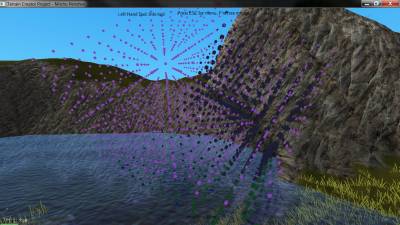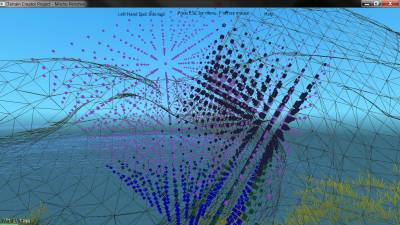The water simulation we went with is not like anything I've read about. There were several methods I considered before going with what we have now.
First was particle water.
The pros: Good water simulation. Realistic waves, breaking etc. possible.
The cons: Hard to extract surface. Impossible to keep track of all particles on any significant planetary scale.
This was obviously not going to work for us.
Height-field based water.
The pros: Significantly less storage. Easy surface extraction. Decent water simulation.
The cons: Braking waves are harder (though not impossible). How do you do a height field based water on a spherical planet? The answer: not well. You can either split into 6 separate height fields, or try to create one with polar coordinates based on a even point distribution.
This is too bad because back before we went for an actual planet, on a flat 2d terrain, this was my top choice
What I went with:
Storing water in a 3d voxel density grid. Much like terrain.
Pros: Storage concerns were already figured out - storing can be done in same datablocks as we store terrain - thus its possible on a planetary scale.
Cons: It's not a very realistic simulation. It's hard to make huge waves.
There was also one other pro, which i didn't realize until later - updating water was made just somewhat easier by the fact that I stored water on a grid. Of course, the grid is NOT oriented with the surface, yet due to a range of densities [-127,127] - it was possible to achieve a perfectly smooth water surface anywhere on the planet despite the grid being all squirrly.
Here are some screenshots of the apparently misaligned grid and the non-the less smooth water surface:


And here is a video of the new water shader:
[media]
[/media]
And a video with the older shader, but the only video of water spreading in a huge hole.
[media]
[/media]
Update: video of the water on a small planet (200m radius)
[media]
[/media]
For more info, and a demo of the project, you can visit at http://blog.milchopenchev.com.
Thanks.


If your spherical planet was generated with oceans on either side, and you dug a hole from the ocean straight through to the core and to the opposite ocean, would A) the water stop falling when it reaches the center of the planet, and B) would the oceans on either side drain (if there was enough space) or would they just generate water without lessening themselves?